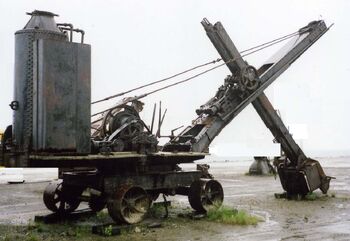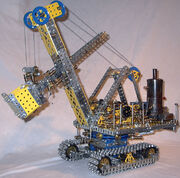
A derelict steam shovel in Alaska; it clearly shows boiler, water tank, winch, main engine, boom, dipper stick, crowd engine, wheels and bucket.
A steam shovel is a large steam-powered excavating machine designed for lifting and moving material such as rock and soil. It is the earliest type of power shovel.
Origins and development[]
The steam shovel was invented by William Otis, who received a patent for his design in 1839.
The first machines were known as 'partial-swing', since the dipper arm could not rotate through 360 degrees. They were built on a railway chassis, on which the boiler and movement engines were mounted. The shovel arm and driving engines were mounted at one end of the chassis, which accounts for the limited swing. Bogies with flanged wheels were fitted, and power was taken to the wheels by a chain drive to the axles. Temporary rail tracks were laid by workers where the shovel was expected to work, and repositioned as required.
Steam shovels became more popular in the latter half of the nineteenth century. Originally configured with chain hoists, the advent of steel cable in the 1870s allowed for easier rigging to the winches.
Later machines were supplied with caterpillar tracks, obviating the need for rails to be laid.
The full-swing, revolving shovel was developed in England in 1884, and this became the preferred format for these machines.
Expanding railway networks (in the US and the UK) fostered a demand for steam shovels; it can be said that the extensive mileage of railways, and corresponding volume of material to be moved, forced the technological leap. As a result, steam shovels became commonplace.
During the 1930s steam shovels lost out to the simpler, cheaper diesel-powered excavating shovels that were the forerunners of those still in use today. Open-pit mines were electrified at this time. Only after the Second World War, with the advent of robust high-pressure hydraulic hoses, did the more versatile hydraulic backhoe shovels take preeminence over the cable-hoisting winch shovels.
Many steam shovels remained quietly at work on the railways of developing nations until diesel engines supplanted them. Most have since been scrapped.
History (US)[]
American manufacturers included the Marion Steam Shovel Company, which was founded in 1884, Erie, P and H, and Bucyrus-Erie Shovel Companies.
The booming cities in North America used shovels to dig foundations and basements for the early skyscrapers. New York's Grand Central Station could not have been built without shovels.
The Panama Canal[]
Perhaps the most famous application of steam shovels is the digging of the Panama Canal across the Isthmus of Panama. One hundred and two shovels worked in that decade-long dig. Seventy-seven were Bucyrus railway shovels, whose booms could rotate less than 180 degrees, the remainder were Marion Shovels. These behemoths moved mountains in their labours. The shovel crews would race to see who could move the most dirt.
Mining[]
Mining also benefitted from steam shovels: the iron mines of Minnesota, the copper mines of Chile and Montana, placer mines of the Klondike – all had earth-moving equipment. But it was with the burgeoning open-pit mines – first in Bingham Canyon, Utah – that shovels came into their own. The shovels systematically removed hillsides. As a result, steam shovels were used around the world from Australia to Russia to coal mines in China. Shovels were also used for construction, road and quarry work.
Later history (US)[]
Steam shovels came into their own in the 1920s with the publicly-funded road building programmes around North America. Thousands of miles of State Highways were built in this time period, together with new factories, such as Henry Ford's River Rouge Plant, and many docks, ports, buildings, and grain elevators. Dams such as the Hoover or Boulder dam could not have been built without steam shovels.
Preservation[]
Most steam shovels have been scrapped, although a few can still be found in industrial museums and private collections.
The Le Roy Marion[]
The world's largest steam shovel surviving intact is a 1906-built Marion machine, located in the small American town of Le Roy, New York. [1]
This machine was bought by the General Crushed Stone Company, who operated the largest rock crusher in the world at a quarry in Le Roy. The shovel, which weighed over 100 tons, was originally mounted on flanged rail-wheels, but was converted to caterpillar tracks in 1923 using a conversion kit manufactured by Marion. [2]
A crew of three men were required to operate it: a fireman, who kept the boiler fed with coal and water; a crane man, who sat on the left-hand side of the boom and tripped the 1 5/8 yard bucket by tugging on a wire rope attached to the bucket; and an engineer (or driver), who raised and lowered the bucket and drove the machine along the track.[3]
This shovel remained in use until 1949, when it was driven out of the quarry and parked by the main road – where it remains to this day, although no longer functional. The Town Council have purchased the land on which it sits, and are planning to apply (in March 2007) for National Landmark status for the shovel.
[]
This machine was originally used at a chalk pit at Arlesey, in Bedfordshire, England. After the pit was closed, the steam navvy was simply abandoned and 'lost' as the pit became flooded with water. By the mid-1970s, the area had become a local beauty spot, known as The Blue Lagoon (from chemicals from the quarry colouring the water), and after long periods of drought, the top of the rusty navvy could be seen protruding from the water. Ruston & Hornsby expert Ray Hooley heard of its existence, and organised the difficult task of rescuing it from the water-filled pit.[4] Hooley arranged for its complete restoration to working order by apprentices at the Ruston Bucyrus works. Subsequently it passed into the care of The Museum of Lincoln Life[5], although it is not known whether it remains in operational condition.
Operation[]
A steam shovel comprises:
- a bucket
- boom and 'dipper stick'
- boiler
- water tank and coal bunker
- steam engines and winches
- operator's controls
- a rotating platform on a truck, on which everything is mounted
- wheels (or sometimes caterpillar tracks or railroad wheels)
- a house (on the platform) to contain and protect 'the works'
The shovel has several individual operations: it can raise or luff the boom, rotate the house, or extend the dipper stick with the boom or crowd engine, and raise or lower the dipper stick.
When digging at a rockface, the operator simultaneously raises and extends the dipper stick to fill the bucket with material. When the bucket is full, the shovel is rotated to load a railway car or motor truck. The locking pin on the bucket flap is released and the load drops away. The operator lowers the dipper stick, the bucket mouth self-closes, the pin relocks automatically and the process repeats.
Steam shovels usually had a three-man crew: engineer, fireman and ground man. There was much jockeying to do to move shovels: rails and timber blocks to move; cables and block purchases to attach; chains and slings to rig; and so on. On soft ground, shovels used timber mats to help steady and level the ground. The early models were not self-propelled, rather they would use the boom to manoeuvre themselves.
Steam shovel manufacturers[]

Model of a steam shovel built from Meccano and powered by a restored 1929 Meccano steam engine. (Model details here)
North American manufacturers:
- Ball Engine Co.
- Bucyrus
- Erie
- Marion Steam Shovel Dredge Company
- Moore Speedcrane (later The Manitowoc Company)
- Northwest Shovels
- Vulcan Iron Works
European manufacturers:
- Demag
- Fiorentini (Italy)
- Lubecker
- Menck
- Orenstein and Koppel GmbH (Germany)
- Ruston & Hornsby (UK)
Power shovels[]
- Main article: power shovel
Large, multi-ton mining shovels still use the cable-lift shovel arrangement.
In the 1950s and 1960s Marion Shovel built massive stripping shovels for coal operations in the Eastern US. Shovels of note were the Marion 360, the Marion 5900, and the Marion 6360 – with a 180-cubic-yard (140 m³) bucket – while Bucyrus constructed one of the most famous monsters: the Big Brutus, the largest power shovel ever built and the largest still in existence. The GEM of Egypt (GEM standing for "Giant Excavating Machine" and Egypt referring to the Egypt Valley in Belmont County, eastern Ohio where it was first put to use), which operated from 1967 to 1988, was of comparable size; it has since been dismantled.[1]
Although these big machines are still called steam shovels, they are more correctly known as power shovels since they use electricity to wind their winches.
Power shovel/dragline manufacturers[]
- Bucyrus International
- Marion Power Shovel
- P&H
- Link Belt
- Komatsu
- Lima Locomotive Works
- Insley
See also[]
- Backhoe
- Bucket-wheel excavator
- Conveyor
- Steam crane
- Crane (railroad)
- Dragline excavator
- Dredge
- Power shovel
- Excavator
- Loader (equipment)
References[]
- ↑ Stein, Shelley (2006-12-11). "Notes to the Town". LeRoy Pennysaver and News. Retrieved on 2007-02-07.
- ↑ Belluscio, Lynne (2006-12-11). "Made Marion". LeRoy Pennysaver and News. Retrieved on 2007-02-07.
- ↑ Belluscio, Lynne (2004-08-23). "Le Roy’s Limestone Quarries". LeRoy Pennysaver and News. Retrieved on 2007-02-07.
- ↑ "Ruston Proctor Steam Navvy No 306 Recovery". (includes photos of navvy at work) (date unknown). Retrieved on 2008-01-03.
- ↑ "The Museum of Lincoln Life (steam engines)". (includes photo of Ruston Proctor no 306) (date unknown). Retrieved on 2008-01-03.
External links[]
- Photo of the Le Roy Marion shovel at work
- The Long Journey of a Steam Shovel – the story of a preserved Ruston-Bucyrus steam shovel in Spain
- http://members.tripod.com/dsmdonaldson/id59.htm
- http://www.copperrange.org/shovel.htm
- http://www.stripmine.org
- http://www.phmining.com/overview/history.html
- http://www.linkbelt.com/linkbelt/about/frameabout.htm
| This page uses some content from Wikipedia. The original article was at Steam shovel. The list of authors can be seen in the page history. As with Tractor & Construction Plant Wiki, the text of Wikipedia is available under the Creative Commons by Attribution License and/or GNU Free Documentation License. Please check page history for when the original article was copied to Wikia |